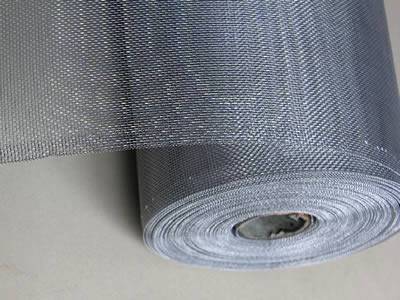Oxidation Coloring Process for Aluminum Window Screens
Aluminum and aluminum alloys have the advantages of small density, light weight, rust resistance, easy processing and they are also easy to process and mold. Aluminum window screens, which are made by this kind of material, possess strong corrosion resistance, long service life, good air permeability and excellent luster. With both decoration and practicability, aluminum window screens in 14 × 14 mesh, 16 × 16 mesh, 18 × 18 mesh, etc. are widely used in hotels, restaurants, hospitals, residential houses and food, chemical, marine aquaculture and many other industries. Following, there is the illustration of the oxidation coloring process for aluminum window screens.
Notice
- The experimental solution is made by chemical reagent and deionized water.
- Oxidation coloring is supplied by direct-current power.
- Unless otherwise indicated, all the processes are under ambient temperature and normal pressure.

OCP-01: Aluminum window screens possess strong corrosion resistance, long service life, good air permeability

OCP-02: Aluminum screen oxidation coloring processing should be completed on professional and specific machines.
Processing technology and formula
In order to obtain good surface decoration effect, you must carried out strict surface pretreatment which directly affects the quality of oxidation coloring for aluminum mosquito screens.
Main production process: unoil → wash → alkali etching → wash → neutralize → wash → polish → wash → activate → wash → oxidize → wash → color → wash → seal → dry → finish.
- Unoil: Remove the oil from the surface of aluminum screens and make the surface be corroded uniformly, in order to eliminate the uneven surface of aluminum screens. The formula and operating conditions are as following:
NaOH 5 g/L, Na3PO4 ∙ 12H2O 50 g/L,
Na2SiO3 ∙ 9H2O 20 g /L, 1 min, 70°C. - Alkali etching: The purpose is to remove all kinds of dirt from the surface of aluminum material by using alkaline cleaning agent. The formula and operating conditions are as following:
NaOH 15 g /L, sodium dodecyl sulfate (SDS) 1 g /L, 1 min, 60°C. - Neutralize: Being unoiled and alkali etched, you must use the acid to neutralize the lye which remains on the surface of aluminum window screens, for the sake of removing its natural oxide film and exposing aluminum matrix. The formula and operating conditions are as following:
H2SO4 13 ml/L, additives 1 ml/L, 0.5 min, room temperature. - Polish
- Chemical polishing: H3PO4 70% (volume ratio), H2SO4 25% (volume ratio), HNO3 5% (volume ratio), 2 min, 90–110°C.
- Electrochemical polishing: H3PO4 50% (volume ratio), H2SO4 25% (volume ratio), additives 20% (volume ratio), diluent 5% (volume ratio), 28 A/dm2, 1 min, 85°C.
- Activate: After the previous treatment, the surface of aluminum window screens must be activated to prevent the formation of natural oxide film, which will affect the quality of oxidation coloring. The formula and operating conditions are as following: KMnO4 3 g/L, H2SO4 12 g/L, additives 2 g/L, 10s, room temperature.
- Oxidize: In order to obtain a certain degree of porosity and film thickness of uniform oxide film to ensure the quality of coloring, this process adopts chemical oxidation or anodic oxidation according to the production conditions.
- Chemical oxidation: HNO3 50ml/L, HF 20 - 30 ml/L, 0.5 min, room temperature.
- Anodic oxidation: H2SO4 180 g/L, 1 A/dm2, 20 min, room temperature.
- Color:
- electrolytic coloring (copper): NiSO4 50 g /L, SnSO4 8g /L, H2SO4 5 g/L, H3BO3 30 g/L, (NH4)2SO4 15g/L, phloroglucin 0.8 g/L. Sn plate, 0.5 min, room temperature.
- Chemical coloring:
- Lacquer black: ATT 6 g/L,35°C, 16 min.
- Dark brown: direct dark brown M 5.5 g/L, 45°C, 16 min.
- Vivid red: alizarin red 8 g/L, 65°C, 10 min.
- Golden yellow: reactive orange K-R 0.5 g/L, 70°C, 13 min.
- Navy blue: Direct light turquoise 5 g/L, 40°C, 3 min.
- Emerald: acid green FV 5 g/L, 70°C, 13 min.
- Silvery white: HNO3 50 mg/L, HF 25 mg/L, room temperature, 0.5 min.
- After coloring, aluminum window screen can be colored multiply, that is, processing organic dyeing after electrolytic coloring to create new colors. This combination can reach dozens.
- Seal: After being colored, the surface of the aluminum window screen still has oxide film with high porosity, absorption and it is easy to be polluted. Thus aluminum window screens need to be boiling water sealed or water vapor sealed to strengthen color fastness and abrasion resistance. This technology is simple and economical. The formula and operating conditions are as following:
- Deionized water, 100°C, 20 min.
- Water vapor 60 min.
- NiSO4 ∙ 7H2O4 5 g/L, CoSO4 ∙ 7H2O 0.6 g/L, H3BO3 4 g/L, NaAc 5 g/L, 85°C, 15 min.
- Dry: Put aluminum window screens which have been sealed in the far-infrared dry oven. The temperature is 50 - 60°C.
Conclusion: Oxidation coloring technology of aluminum window screen is a mature production technology which is suitable for aluminum alloy and also its alloy products. This technology is easy to operate, easy access to materials, economical and with high economic effects.
